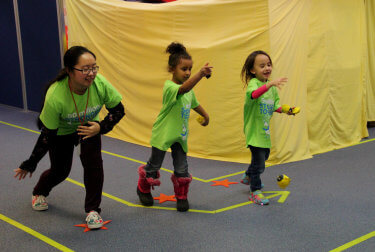Health and wellness teaching is rapidly becoming a vital part of the school day. More and more children and youth are coming to school with conditions that are negatively impacting their lives. No longer can health and wellness be considered an “if we have time we’ll get to it” part of a school day. As evidenced by the data, children and youth are increasingly entering our classrooms anxious, lacking self-confidence, and suffering from a litany of social, emotional and physical health concerns. Therefore, it’s more important than ever for schools to continue to find ways to effectively provide students with opportunities to develop essential health and wellness skills.

One Way…Sharing the Responsibility
One of the most effective ways to impact health and wellness behaviors in students is through comprehensive programming (Joint Consortium for School Health, 2010). For example, Canadian authorities have attempted to approach this challenge through Comprehensive School Health (CSH) programming. It is widely accepted that CSH supports student learning, while simultaneously addressing school health and wellness in a planned, integrated and holistic manner (Berg et al., 2017).
In many ways, education and health are interdependent. Students are better learners when they are healthy and well, and better educated people tend to be healthy (Joint Consortium for School Health, 2010). As student health and wellness extends beyond the classroom, a comprehensive framework that shares and integrates responsibility is a practical answer that creates a joint ownership of responsibility (Joint Consortium for School Health, 2010).
A comprehensive approach to health and wellness looks beyond what is happening in an individual classroom, and encourages the support of the whole school and extended community. It can involve multiple personnel, agencies, and programs both in and out of the school environment to assist in meeting student health and wellness needs, and assist in developing health and wellness literacy. Such a framework is designed to not only engage students with the issues and decisions that they presently might face, but also to support them in ensuring that they can maintain and improve their health and wellness throughout their lives. It assists students in developing and demonstrating increasingly sophisticated health and wellness related knowledge, skills and attitudes.
Benefits of a Comprehensive Approach to Health and Wellness
When it comes to student health and wellness, developing a comprehensive approach has several benefits, including:
- Encouraging and promoting health and wellness lifestyle choices
- Incorporating health and wellness into every aspect of school
- Identifying links between health and education issues and systems
- Supporting families and the community
A comprehensive approach to health and wellness is an effective way to improve both health and education outcomes. However, it has to be recognized that the teacher alone cannot be responsible for the entire development of student health and wellness. A truly comprehensive approach must include the teacher, school and community.
Role of the Teacher
Although Heath Education teachers hold a key leadership role in the delivery of health curriculum programming, all teachers share the responsibility for health and wellness education regardless of the curriculum area being taught or the teacher’s curriculum specialization. All teachers need to ensure that students acquire the knowledge, skills and attitudes that will lead to positive health and wellness lifestyles. Also, all teachers are constantly on display in front of their students and have a unique opportunity to role model positive health and wellness behaviors. As ‘observational’ learning is a powerful and influential form of learning, all teachers share professional responsibility for portraying personal behaviors that mirror and reinforce positive health and wellness behaviors for students.
Teachers can support a comprehensive approach to health and wellness by:
- Understanding and appreciating the importance of health and wellness in their school
- Supporting the development of a comprehensive approach to school health and wellness
- Utilizing where appropriate, methods to meet learning outcomes across all subject areas
- Delivering developmentally appropriate lessons
- Employing materials, resources, and personnel from the school, home and community
- Role modeling an active, healthy lifestyle

Role of the School
Coordination is a key ingredient to successfully promoting a comprehensive approach to health and wellness in schools. A coordinated program is more than a collection of ideas, thoughts, and individual lessons, with each teacher conducting their own lessons and program (Berg et al., 2017). School personnel need to foster partnerships to ensure that activities, lessons and initiatives are coordinated to maximize the success of a school-wide health and wellness program. The goal of such a program is to develop and deliver an organized, sequential plan for teaching all students the necessary life skills that promote health and wellness.
Active partnerships between students, teachers, parents, health professionals and the community need to be emphasized to maximize optimum student health and wellness. Schools should foster and support a wide range of health and wellness promoting activities and services that occur in both the school and the community. Considerations include: physical condition of the buildings; playgrounds; management of noise; lighting; and air and water quality (Berg et al., 2017).
Through the consistent implementation of health and wellness promoting policies, the quality of a school’s overall environment can be maintained. Health and wellness education must be both accessible and meaningful to students regardless of age, gender, race, ability, socioeconomic status and/or religion. For this to happen, it’s imperative that students are provided with supportive and engaging school environments where they feel accepted and valued.
Role of the Community
Schools must be perceived as agencies of the community. Families, friends, local organizations and students themselves must play a critical role in health and wellness education (Anspaugh & Ezell, 2010). A wide-ranging set of complex and interacting variables that exist in communities influence health and wellness issues. As students are influenced by actions and behaviors in their homes, neighborhoods, local malls, recreation centers, etc., schools cannot take sole responsibility when a community experiences students who have developed problem behaviors in high ‘risk’ activities such as substance abuse and violence. Hence, for any prevention and intervention programming to be effective, programs must be based on a collaborative approach involving the whole community. Hence, the importance for a ‘comprehensive’ approach to the teaching of student health and wellness.
Concluding Thoughts
Teaching for health and wellness is a critical part of student learning. As children and youth continue to enter our classrooms with debilitating social, emotional and physical conditions, it’s vital for schools to commit to effectively teaching health and wellness. However, health education and physical education teachers cannot be expected to fulfill this mission alone. A comprehensive approach that involves the teacher, school and community is essential. Student benefits will be maximized when teachers, schools and communities work closely together to plan for and deliver quality health and wellness learning opportunities for their students.
References
Anspaugh, D.J., & Ezell, G. (2010). Teaching today’s health. (9th ed.). Pearson: San Francisco, CA.
Berg, S., Hickson, C., Bradford, B., & Fishburne, G. (2017). Teaching for health & wellness in children and youth. Ripon Publishing: Victoria, BC.
Joint Consortium for School Health. (2010). What is comprehensive school health? Retrieved from www.jcsh-cces.ca
